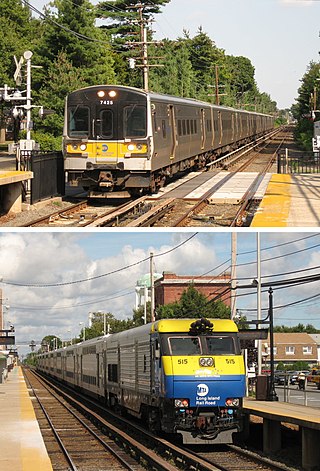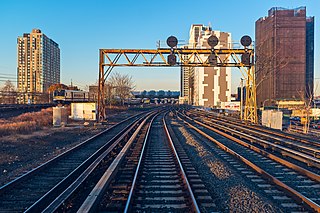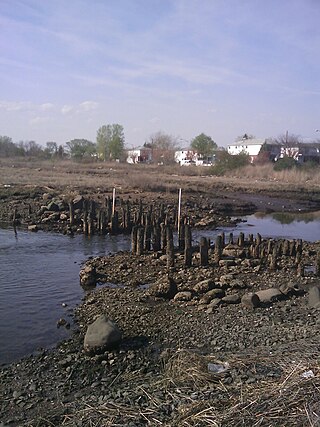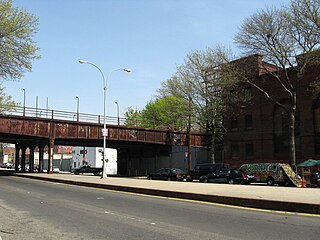
The Long Island Rail Road, often abbreviated as the LIRR, is a railroad in the southeastern part of the U.S. state of New York, stretching from Manhattan to the eastern tip of Suffolk County on Long Island. The railroad currently operates a public commuter rail service, with its freight operations contracted to the New York and Atlantic Railway. With an average weekday ridership of 354,800 passengers in 2016, it is the busiest commuter railroad in North America. It is also one of the world's few commuter systems that runs 24/7 year-round. It is publicly owned by the Metropolitan Transportation Authority, which refers to it as MTA Long Island Rail Road. In 2023, the system had a ridership of 75,186,900, or about 253,800 per weekday as of the fourth quarter of 2023.

Valley Stream is a train station located on the Atlantic Branch of the Long Island Rail Road, in the Incorporated Village of Valley Stream, in Nassau County, New York.

The Port Jefferson Branch is a rail line and service owned and operated by the Long Island Rail Road in the U.S. state of New York. The branch splits from the Main Line just east of Hicksville and runs northeast and east to Port Jefferson. Several stations on the Main Line west of Hicksville are served primarily by trains bound to/from the Port Jefferson branch, so LIRR maps and schedules for the public include that part of the Main Line in the "Port Jefferson Branch" service.

The City Terminal Zone is the set of Long Island Rail Road lines within New York City west of Jamaica station, except the Port Washington Branch.

The Babylon Branch is a rail service operated by the Long Island Rail Road in the U.S. state of New York. The term refers to the trains serving Montauk Branch stations from Valley Stream east to Babylon; in other words, the Babylon Branch is a rail service rather than an actual track. The electrification of the Montauk Branch ends east of the Babylon station, so the Babylon Branch is mostly served by electric trains.

The Montauk Branch is a rail line owned and operated by the Long Island Rail Road in the U.S. state of New York. The line runs the length of Long Island, 115 miles (185 km) from Long Island City to Montauk. However, in LIRR maps and schedules for public use, the term Montauk Branch refers to the line east of Babylon; service from Jamaica to Babylon is covered by separate Babylon Branch schedules, while the line west of Jamaica is currently unused for passenger service. A select number of Montauk Branch trains operate via the Main Line during peak hours.

The Ronkonkoma Branch is a rail service operated by the Long Island Rail Road (LIRR) in the U.S. state of New York. On LIRR maps and printed schedules, the "Ronkonkoma Branch" includes trains running along the railroad's Main Line from Hicksville to Ronkonkoma, and between Ronkonkoma and the Main Line's eastern terminus at Greenport. The section of the Main Line east of Ronkonkoma is not electrified and is referred to as the Greenport Branch.

The West Hempstead Branch is an electrified rail line owned and operated by the Long Island Rail Road (LIRR). It runs between Valley Stream and West Hempstead, in Nassau County, New York, United States.

The Kew Gardens station is a station on the Main Line of the Long Island Rail Road (LIRR). It is located in the Kew Gardens neighborhood of Queens, New York City, near Austin Street and Lefferts Boulevard. The station is located within the City Terminal Zone, part of LIRR fare zone 1. It contains four tracks and two side platforms for the outermost tracks.

The Central Branch is a rail line owned and operated by the Long Island Rail Road (LIRR) in the U.S. state of New York, extending from 40.734°N 73.470°W just east of Bethpage station to 40.696°N 73.341°W just west of Babylon station. It was built in 1873 as part of the Babylon Extension of the Central Railroad of Long Island (CRRLI), which was owned by Alexander Turney Stewart. The branch was mostly unused following the 1876 merger of the CRRLI and the LIRR, but in 1925 it was rebuilt and reconfigured to connect Bethpage and Babylon stations.

The Main Line is a rail line owned and operated by the Long Island Rail Road in the U.S. state of New York. It begins as a two-track line at Long Island City station in Long Island City, Queens, and runs along the middle of Long Island about 95 miles (153 km) to Greenport station in Greenport, Suffolk County. At Harold Interlocking approximately one mile east of Long Island City, the tracks from the East River Tunnels and 63rd Street Tunnel into Manhattan intersect with the Main Line, which most trains use rather than using the Long Island City station.

The Cedarhurst Cut-off was a rail line owned and operated by the Long Island Rail Road in the U.S. state of New York. The line split from the LIRR's Main Line at Rockaway Junction and ran south via Springfield Gardens and Cedarhurst and on to Far Rockaway. The part north of the crossing of the old Southern Railroad of Long Island at Springfield Junction is now part of the Montauk Branch, while the rest has been abandoned in favor of the ex-Southern Far Rockaway Branch.
The Long Island Rail Road is a railroad owned by the Metropolitan Transportation Authority in the U.S. state of New York. It is the oldest United States railroad still operating under its original name and charter. It consolidated several other companies in the late 19th century. The Pennsylvania Railroad owned the Long Island Rail Road for the majority of the 20th century and sold it to the State in 1966.

The Rockaway Beach Branch was a rail line owned and operated by the Long Island Rail Road in Queens, New York City, United States. The line left the Main Line at Whitepot Junction in Rego Park heading south via Ozone Park and across Jamaica Bay to Hammels in the Rockaways, turning west there to a terminal at Rockaway Park. Along the way it connected with the Montauk Branch near Glendale, the Atlantic Branch near Woodhaven, and the Far Rockaway Branch at Hammels.

The Richmond Hill station is a closed station on the Montauk Branch of the Long Island Rail Road in the Richmond Hill neighborhood of Queens in New York City. The station is located at Myrtle Avenue and cuts diagonally from the intersection of Jamaica Avenue and Lefferts Boulevard through to Hillside Avenue. The station has two tracks and an island platform. Richmond Hill was the only station on the Lower Montauk Branch that was elevated with a high-level platform for passengers to wait for trains; the others were at ground level, with low-level platforms.
Central Railroad of Long Island was built on Long Island, New York, by Alexander Turney Stewart, who was also the founder of Garden City. The railroad was established in 1871, then merged with the Flushing and North Side Railroad in 1874 to form the Flushing, North Shore and Central Railroad. It was finally acquired by the Long Island Rail Road in 1876 and divided into separate branches. Despite its short existence, the CRRLI had a major impact on railroading and development on Long Island.
Community gardens in New York City are urban green spaces created and cared for by city residents who steward the often underutilized land. There are over 550 community gardens on city property, over 745 school gardens, over 100 gardens in land trusts, and over 700 gardens at public housing developments throughout New York City. The community garden movement in NYC began in the Lower East Side during the disrepair of the 1960s on vacant, unused land. These first gardens were tended without governmental permission or assistance.

The Cannonball is a seasonal named train operated by the Long Island Rail Road between Penn Station in New York City and the Montauk station on Long Island, New York. The train operates from May through October, running Fridays to Montauk and Sundays to New York.
The Green Guerillas are a community group of horticulturalists, gardeners, botanists, and planners who work to turn abandoned or empty spaces in New York City into gardens. Formed in the 1970s, the group threw "seed grenades" into derelict lots and developed community gardens, often without going through official channels. It became especially popular after the concerted redevelopment of a dangerous, trash-filled space at the corner of Houston Street and Bowery in Manhattan. The resulting press coverage and word of mouth led the group to broaden its activities from active gardening to education, training, and support for a number of community groups working on their own gardens. The Green Guerillas have been credited with beginning the community garden movement and popularizing the idea of guerilla gardening.

The Montauk Cutoff is an abandoned railway in Long Island City, Queens, New York City, that connected the Long Island Rail Road's Main Line and Lower Montauk Branch.















